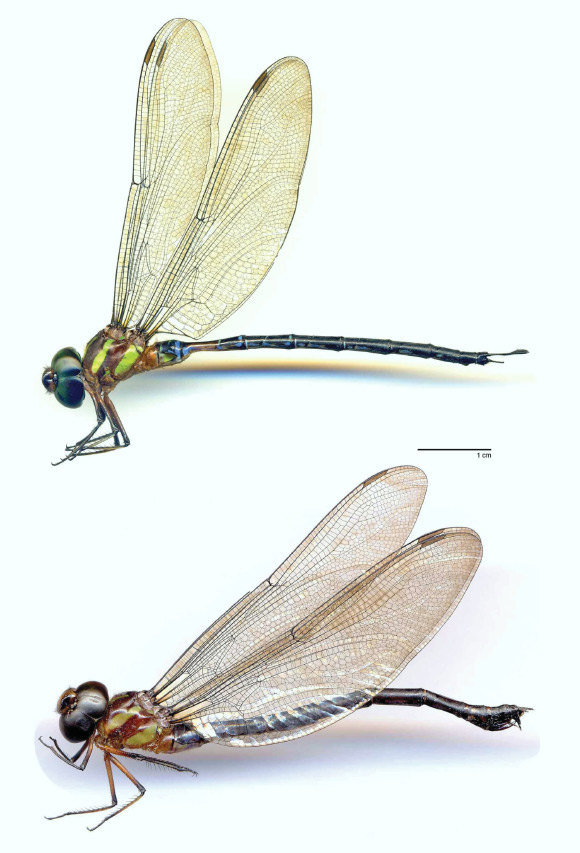Beautiful New Species of Dragonfly Discovered
Nov 6, 2019 by Natali Anderson
A new species of dragonfly, officially named Gynacantha vargasi, has been discovered on the Caribbean slope of Costa Rica.

Gynacantha vargasi, a male (top) and a female. Image credit: William A. Haber, doi: 10.11646/zootaxa.4612.1.3.
The newly-discovered species belongs to the genus Gynacantha, a group of almost 100 species distributed through the tropics and subtropics of the New World, Africa, Asia, and the western Pacific.
In the New World, these dragonflies range from south Texas and Florida through the West Indies, and south to northern Argentina, with the highest diversity in Central America and tropical South America.
Most species are large with body lengths ranging from about 2.2-3.3 inches (5.5-8.5 cm), but a few are only 1.8-2 inches (4.5-5 cm).
Many species are drab-colored, dull green and brown and are active mainly at dusk and dawn.
In others, males perch next to breeding sites, such as small forest pools, where they guard territories during the day.
Scientifically named Gynacantha vargasi, the newfound species is a brightly patterned dragonfly that patrols over forest pools or perches along forest edges during the day.
“This species is named in honor of Ronald Vargas Castro, one of Costa Rica’s great naturalists, a trusted companion who has accompanied me on many Odonata expeditions in Costa Rica and Ecuador and who has collected numerous rare and undescribed species of Odonata, including two of the four known specimens of this new Gynacantha,” explained Dr. William Haber, an entomologist from Monteverde, Costa Rica.
The researchers collected adult individuals of Gynacantha vargasi on the Caribbean slope of Costa Rica during the wet season in April, June, August, and November.
“A foraging female and a patrolling male were found during the day, suggesting that the species is diurnal (daytime),” Dr. Haber said.
“Its bright coloration also argues for diurnality.”
Gynacantha vargasi is described in a paper in the journal Zootaxa.
_____
William A. Haber. 2019. Gynacantha vargasi (Odonata: Anisoptera: Aeshnidae) sp. nov. from Costa Rica. Zootaxa 4612 (1); doi: 10.11646/zootaxa.4612.1.3
Thanks to: www.sci-news
Nov 6, 2019 by Natali Anderson
A new species of dragonfly, officially named Gynacantha vargasi, has been discovered on the Caribbean slope of Costa Rica.

Gynacantha vargasi, a male (top) and a female. Image credit: William A. Haber, doi: 10.11646/zootaxa.4612.1.3.
The newly-discovered species belongs to the genus Gynacantha, a group of almost 100 species distributed through the tropics and subtropics of the New World, Africa, Asia, and the western Pacific.
In the New World, these dragonflies range from south Texas and Florida through the West Indies, and south to northern Argentina, with the highest diversity in Central America and tropical South America.
Most species are large with body lengths ranging from about 2.2-3.3 inches (5.5-8.5 cm), but a few are only 1.8-2 inches (4.5-5 cm).
Many species are drab-colored, dull green and brown and are active mainly at dusk and dawn.
In others, males perch next to breeding sites, such as small forest pools, where they guard territories during the day.
Scientifically named Gynacantha vargasi, the newfound species is a brightly patterned dragonfly that patrols over forest pools or perches along forest edges during the day.
“This species is named in honor of Ronald Vargas Castro, one of Costa Rica’s great naturalists, a trusted companion who has accompanied me on many Odonata expeditions in Costa Rica and Ecuador and who has collected numerous rare and undescribed species of Odonata, including two of the four known specimens of this new Gynacantha,” explained Dr. William Haber, an entomologist from Monteverde, Costa Rica.
The researchers collected adult individuals of Gynacantha vargasi on the Caribbean slope of Costa Rica during the wet season in April, June, August, and November.
“A foraging female and a patrolling male were found during the day, suggesting that the species is diurnal (daytime),” Dr. Haber said.
“Its bright coloration also argues for diurnality.”
Gynacantha vargasi is described in a paper in the journal Zootaxa.
_____
William A. Haber. 2019. Gynacantha vargasi (Odonata: Anisoptera: Aeshnidae) sp. nov. from Costa Rica. Zootaxa 4612 (1); doi: 10.11646/zootaxa.4612.1.3
Thanks to: www.sci-news






 Sat Mar 23, 2024 11:33 pm by globalturbo
Sat Mar 23, 2024 11:33 pm by globalturbo

